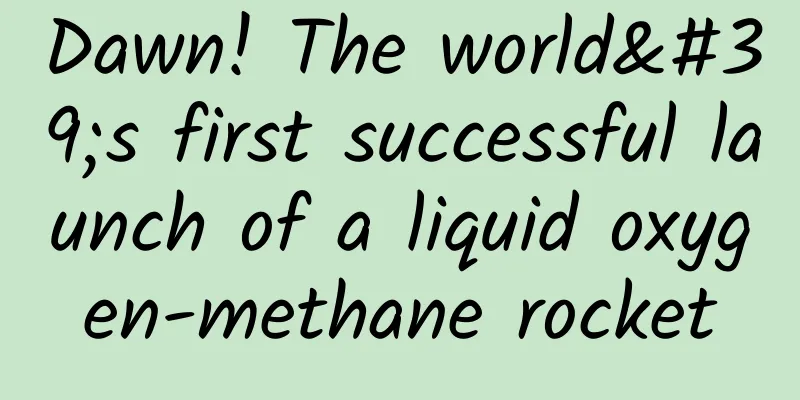Dawn! The world's first successful launch of a liquid oxygen-methane rocket

|
At around 9:00 a.m. on July 12, the Suzaku-2 Yao-2 rocket of China's private aerospace company Blue Arrow Aerospace ignited and took off from the Jiuquan Satellite Launch Center. The launch mission was a complete success, becoming the world's first liquid oxygen-methane rocket to successfully send a payload into a predetermined orbit, marking that the popular "liquid oxygen-methane trend" in recent years has taken a solid first step towards practical application. So what are the benefits of choosing liquid oxygen-methane propellant for rockets? What application prospects do liquid oxygen-methane rockets have? From stove to rocket Although the practical application of liquid oxygen-methane rocket engines has gradually attracted attention in recent years, its "germination" dated back quite a long time ago. In March 1931, German rocket pioneer Johannes Winkler presided over the launch of the world's first liquid oxygen-methane rocket, the "Hückel-Winkler 1". The rocket looked very different from today's successors. The fuel was stored in a tube, and the only engine was located in the center of the rocket. Unfortunately, the rocket only flew to an altitude of about 60 meters, and there was no practical value in that era, so it failed to make a splash. In the mid-20th century, the space age arrived and liquid rockets saw great development. However, at that time, liquid rocket engines chose kerosene and liquid hydrogen as their main fuels, and methane was still "absent", which was closely related to its industrial technology level and application scope. Methane is the main component of natural gas. Although natural gas was discovered very early, it did not receive enough attention from the energy market for most of the 20th century. This was mainly due to the late maturity of natural gas liquefaction technology, insufficient industrial processing capacity, and high cost of use, which naturally made it difficult to be a cheap option for aerospace fuel. With technological advances and changes in demand, natural gas accounts for an increasingly larger share of energy transactions: in 1970, due to limitations in liquefaction technology, global natural gas trade volume was only 3 billion cubic meters; by 2021, this figure had exceeded 1 trillion cubic meters. Japan, the European Union and other countries have gradually used natural gas as their main energy source, and natural gas refining, processing, storage and other technologies have become more mature, promoting more diversified methane application scenarios. As natural gas is delivered to kitchen stoves and factory units in thousands of households, its advantages such as high combustion efficiency, environmental protection, low cost and easy production are becoming increasingly prominent, and methane has gradually become a fuel option that rocket engine researchers cannot ignore. In fact, the natural gas produced by some high-quality gas fields is of excellent quality. After liquefaction, it can be directly used as fuel for rocket engines without additional purification steps. In the 1960s, American aerospace companies began to explore the early practical application of methane rocket fuel, and accumulated considerable experience in the preparation and application of liquid oxygen-methane propellants. In the 1980s, my country also carried out preliminary research on methane rocket fuel engines, and successively carried out methane and propane electric heat transfer tests and thrust chamber ignition tests, and achieved initial results. Many aerospace power research units have accumulated a large number of research results and experience, laying a solid foundation for the flight of liquid oxygen-methane engines. In addition, ESA, Russia, India and other countries are also conducting research on liquid oxygen-methane engines, but none of them have yet produced a practical engine model, and the research is still in a relatively early stage. The new favorite of power has many advantages Although aerospace industries of various countries started research on methane rocket fuel early on, due to various restrictions and considerations, liquid oxygen-methane engines were unable to propel rockets into orbit throughout the 20th century. Instead, they remained a technology verifier and explorer in obscurity. It was not until the 2020s, after more than half a century of technological development, that liquid oxygen-methane engines finally reached the "threshold" of practical application. Almost at the same time, reusable rocket technology gradually matured, prompting liquid oxygen-methane propellants to play to their strengths and avoid their weaknesses, becoming the "new favorite" of future rocket propulsion. In terms of propellant performance, liquid oxygen-methane has its own advantages and disadvantages compared to traditional liquid oxygen-kerosene. In terms of density, under the same design conditions, the combined density of liquid oxygen-methane is about 20% lower than that of liquid oxygen-kerosene, which means that the energy density of liquid methane is not as good as that of liquid oxygen-kerosene; in terms of specific impulse, the theoretical specific impulse of methane is slightly higher than that of kerosene by 3%, but the specific impulse is easily affected by factors such as the engine cycle mode, so the specific impulse of kerosene and methane can be said to be basically the same; in terms of cooling effect, methane shows its advantages as a cryogenic fuel. Thanks to the specific heat capacity index, its comprehensive cooling capacity is more than 3 times that of kerosene, and as a carbon-containing fuel, it is not easy to coke and deposit carbon, which is more "friendly" for the actual use of the engine. Methane has a natural advantage in engine maintainability. Today, reusable rockets are becoming a general trend. Liquid oxygen-kerosene rockets must have their engines thoroughly cleaned after recovery before they can be used again. Liquid methane is a highly volatile fuel, so liquid oxygen-methane engines significantly reduce the workload of logistics maintenance. The use of methane fuel has also had a very positive impact on the rocket's structural design, such as in rocket tanks. Liquid oxygen, as an oxidizer, has a boiling point of about minus 183 degrees Celsius, and methane, as a reducing agent, has a boiling point of about minus 161 degrees Celsius. The two are relatively close, far from the huge difference in boiling point temperature between liquid oxygen and liquid hydrogen. Therefore, when choosing clean fuel, liquid oxygen and methane rockets are convenient for using cryogenic propellant common bottom tanks, thereby effectively reducing the weight of the tanks, shortening the length, and reducing the weight of the rocket body, enhancing the carrying capacity, and making up for the disadvantage in combined density. In addition, methane is highly volatile, so the tank can adopt a self-generated pressurization design to further help efficient weight reduction. To sum up, liquid oxygen-methane engines have powerful performance and low operating costs. Their comprehensive characteristics are very suitable for the development trend of reusable rocket technology. It is no surprise that they have become the "darling" of rockets in the new era. Climb to the top with accumulated experience This mission is the second launch of the Suzaku-2 rocket. Its first launch was on December 14 last year. Unfortunately, during the flight of the second stage of the rocket, the engine pipeline broke, causing the aircraft to malfunction and the payload failed to enter orbit. In the first half of this year, two foreign liquid oxygen-methane rockets have challenged the first flight into orbit, namely the Terran-1 rocket of Relativity Space and the "Starship" of SpaceX, but unfortunately both failed. The Suzaku-2 rocket team promptly restored the fault and achieved success after improvements, which is not easy. According to public information, many private aerospace companies in my country, including Blue Arrow Aerospace, Jiuzhou Cloud Arrow, Interstellar Glory, and Space Propulsion, are developing liquid oxygen and methane rockets and engines, and have achieved relatively impressive results. Among them, Blue Arrow Aerospace has made the fastest progress. The "Tianque-12" developed by the company is the first liquid oxygen-methane engine put into use in China. It adopts a gas generator cycle, has a sea level thrust of 67 tons, a sea level specific impulse of 286 seconds, a vacuum thrust of 80 tons, a vacuum specific impulse of 337 seconds, and a chamber pressure of about 10 MPa. The first stage of the Suzaku-2 rocket is equipped with four "Tianque-12" engines, with a takeoff thrust of up to 268 tons. Blue Arrow Aerospace is still continuously improving this engine, and the new model "Tianque-12A" is expected to debut on the first stage of the Suzaku-2 rocket in the future. Currently, the second stage of the Suzaku-2 rocket is equipped with a single "Tianque-12" and "Tianque-11" 10-ton liquid oxygen-methane swimming engine. Among them, the second-stage "Tianque-12" is in the same state as the first-stage engine and has not been vacuum optimized. In the future, the Suzaku-2 rocket will cancel the swimming engine and replace it with the "Tianque-15A" 80-ton variable thrust pump forward swing liquid oxygen-methane engine, which can be considered as a vacuum optimized and improved version of the "Tianque-12A". In the future, after the successful application of "Tianque-12A" and "Tianque-15A", the Suzaku-2 rocket is expected to further increase its capacity while reducing costs, meet more types of launch needs, and adapt to the future commercial space launch market needs. At the same time, my country's aerospace "national team" is also working hard to advance the research and development of higher-level liquid oxygen-methane rocket engines. At least 80-ton and 200-ton liquid oxygen-methane engines are being steadily tested and will become the preferred power choice for my country's future large and medium-sized rockets. Looking around the world, many foreign liquid oxygen-methane rockets are under development, or are stepping up engine testing, or have begun intensive rocket assembly testing, and some models have very high performance indicators. For example, Blue Origin's BE-4 engine has a sea level thrust of 240 tons and is said to be reusable 100 times; SpaceX has even made a bold statement of "striving to make the Raptor engine thrust exceed 270 tons and the takeoff thrust of the 'Starship' exceed 9,000 tons." Faced with the booming tide of recyclable and reusable rockets and liquid oxygen-methane engines, I believe that my country's aerospace personnel will track industry trends in a timely manner, combine their own conditions and actual needs, and promote the level of liquid oxygen-methane rockets and engines to a new level. (Author: Shi Xiaolong) |
<<: Why are succulents drought-tolerant?
Recommend
Is there any shortcut to start a short video business? Is it possible to make short videos quickly?
It seems to be human nature to be eager for quick...
iQIYI’s high-quality barrage advertising operation process and advantages!
After summarizing the many characteristics of iQi...
Talking about the open Internet platform: "Decentralization" is the general trend
A few days ago, I talked with a friend about crow...
Best practices for cache penetration, cache concurrency, and hotspot caching
1. Introduction When we use cache, whether it is ...
WeChat now supports changing WeChat ID! Can't change yours? Here's a trick to fix it
Now, the latest Android version of WeChat support...
Two English teachers want to rule the world? What will happen if Hammer "gets on board" with Alibaba?
"Two English teachers are going to rule the ...
Operational promotion: 4 general methods and techniques to increase followers!
Today, we will share 4 general tips for increasin...
When using azithromycin to treat mycoplasma pneumonia, remember these 6 details!
In recent times, patients with respiratory diseas...
Apple's bottom line from cracking down on App ranking manipulation
In the past two days, the news that Apple cracked...
How far can Luo Yonghao’s “Bullet Messenger” fly?
[[241148]] one The Luo family crosstalk performan...
China Passenger Car Association: Analysis of my country's passenger car production capacity issues in 2021
After three years of continuous negative growth, ...
Let me give you an example of the pitfalls I encountered when making event products (data review)
Let’s review the activity process first: 1. Total...
Why is it so easy to gain weight, but so difficult to lose weight?
Reviewer of this article: Chen Haixu, Deputy Dire...
Are there any places to enjoy tea in Ningbo? Does anyone have any recommendations for specialty teas?
Ningbo Tea Studio recommends high-end tea SPA in-...
Attached case | By promoting information flow in this way, the conversion rate can be increased by 50% without any pressure!
A few days ago, we conducted a small survey in th...









